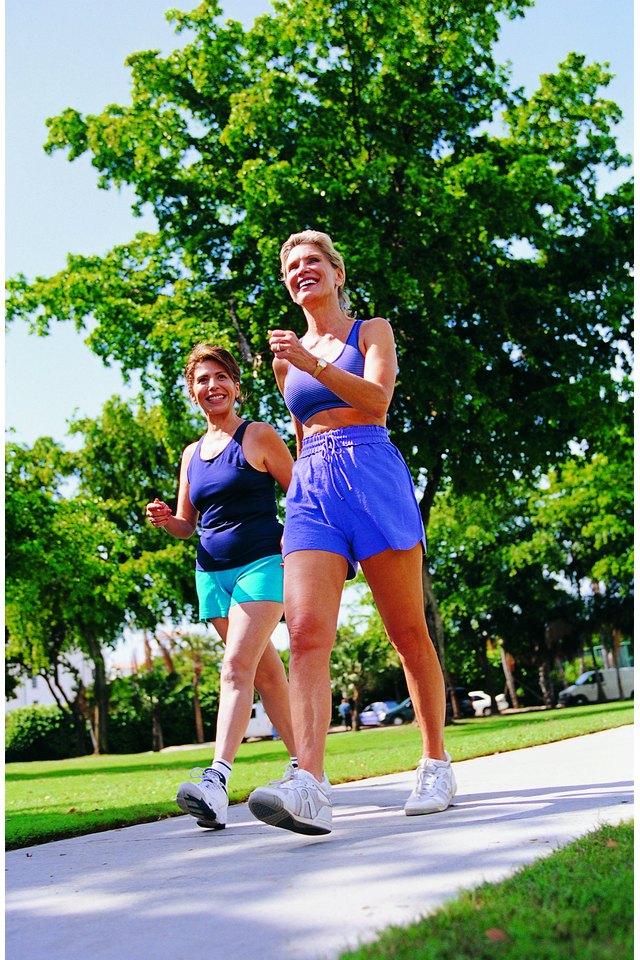Race Walking vs. Power Walking

Race walking and power walking, which is also known as speed walking, are excellent exercises because they burn far more calories than what “The Complete Guide to Walking for Health, Weight Loss and Fitness” author Mark Fenton calls “regular walking” and they cause far fewer injuries than running. Race walking and power walking each require different techniques than regular walking. Race walking’s techniques are formal rules because race walking is a competitive sport, while power walking is not.
Power Walking Techniques
The “walking speed limit for regular walking” is approximately 4.5 mph, wrote Fenton. Regular walking is a natural activity. Power walkers, though, can reach 5.5 mph by consciously changing their posture, taking faster steps, and swinging their arms. If you want to power walk, you should walk so upright that your head is level and only your eyes move when you look at your feet. You should “walk as tall as you can,” wrote Fenton. Taking 135 to 150 steps per minute will improve your speed more than longer strides, which can strain your buttocks, hamstrings and lower back. Swinging your arms while they are bent 90 degrees and your elbows are in a fixed position will also improve your speed.
Race Walking Techniques
Competitive race walking dates back to the late 1700s, wrote Fenton. Today, there are races all over the world. The 2012 Olympics included 20-km walks for men and women and a 50-km walk for men. Race walkers can reach more than 8 mph, but their activity is very unnatural. Race walking has two rules. One rule requires that one of your feet must be touching the ground at all times. This means that the heel of your front foot must touch the ground before your back foot comes off the ground. The second rule requires your front foot’s knee to be straight from the time your front foot’s heel touches the ground until the rest of your body passes over that leg.
Weight Loss Comparisons
Race walking burns more calories than running at the same speed because the sport’s rules require them to expend more effort, according to “An Invitation to Health” author Dianne Hales. Race walkers have shorter strides than runners and, thus, must stretch their hips forward and backward. Race walking 8 mph can burn more than 1,000 calories per hour in 150-pound people. The same people burn about 800 calories per hour race walking 6 mph, about 600 calories per hour power walking 5 mph, and about 400 calories per hour walking 4 mph, wrote Fenton. You lose 1 pound when you burn 3,500 calories. Race walkers and power walkers also are far less likely to get hurt than runners because they hit the ground with about 1-1/2 times their weight to runners’ three to four times their weight.
Improving Your Speed
Race walking requires more arm strength and leg strength than power walking. Consequently, race walkers need to do more strength exercises. The best strength exercises for race walkers and power walkers include chest presses and bicep curls for your upper body, squats for your lower body, and abdominal crunches for both. Fenton recommends strength exercises 20 minutes daily four times weekly, but prospective competitive athletes should do more. The American College of Sports Medicine recommends eight to 12 repetitions of eight to 10 different strength exercises two to three times weekly to improve your performance in all aerobic activities, including walking.
References
- "The Complete Guide to Walking for Health, Weight Loss, and Fitness"; Mark Fenton; 2008
- "An Invitation to Health"; Dianne Hales; 2010
- Harvard Men's Health Watch: Walking: Your Steps to Health
- American College of Sports Medicine: The Recommended Quantity and Quality of Exercise; 1998
- The Walking Site: Racewalking
Resources
- “The Complete Guide to Racewalking: Technique and Training”; Dave McGovern; 1998
- The Walking Site: How to Walk
- The Merck Manual Home Health Handbook: Choosing the Right Exercise
Writer Bio
Jay Schwartz has had articles printed by the "Chicago Tribune," "USA Today" and many other publications since 1983. He's covered health, fitness, nutrition, business, real estate, government, features, sports and more. A Lafayette, Pa. college graduate, he's also written for several Fortune 500 corporate publications and produced business newsletters.
